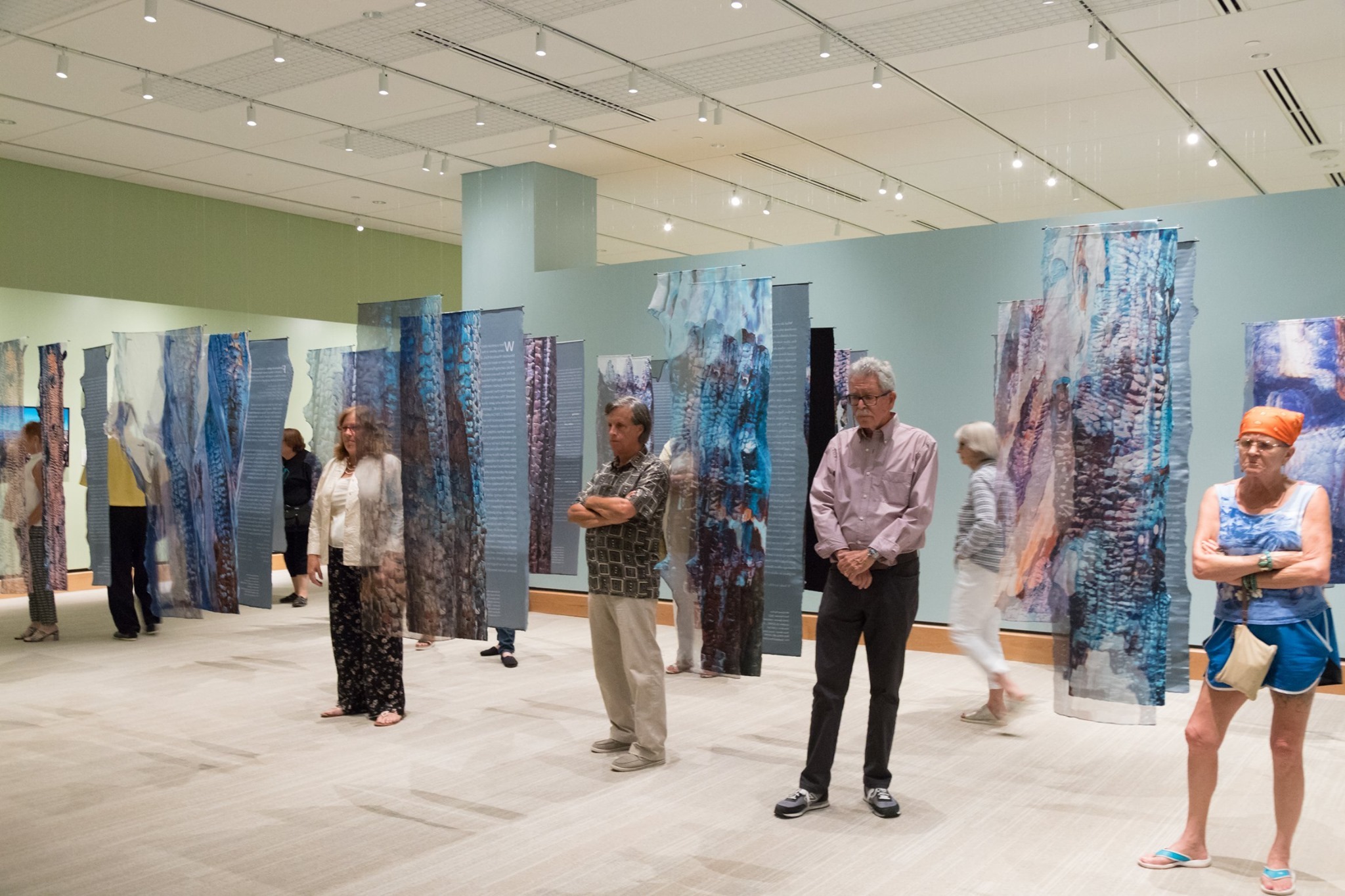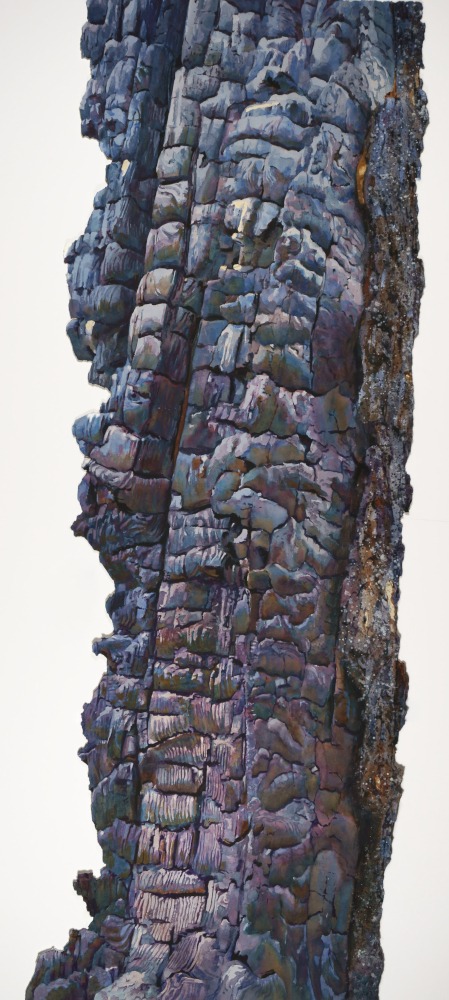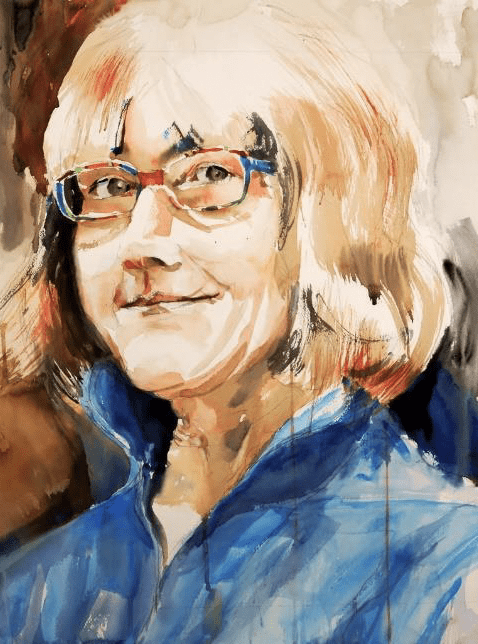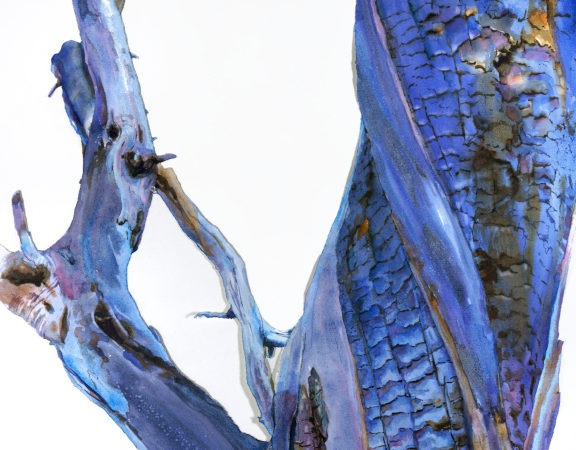State of the Forest by Suze Wolf will be on display at World Forestry Center’s Discovery Museum in Portland, Oregon, from February 1 to April 30, 2024. The museum is open Wednesday to Sunday from 11 am to 4 pm.
An Introduction by Tim Hecox, Director of Experience, World Forestry Center’s Discovery Museum
For over half a century, World Forestry Center has been at the intersection of people and forestry. Founded in 1966, WFC is a nonprofit organization dedicated to creating and inspiring champions of sustainable forestry. Our programs are designed to shape a society that values and takes action in support of the economic, ecological, and social benefits of forests. Our focus is not on forests alone but rather on how people think, act, and relate to them.
The opportunity to host State of the Forest comes at an impactful time as we are initiating new and innovative programming that will address the most pressing issues affecting the health of our forests and communities. World Forestry Center seeks to amplify the voices of community members who are deepening their understanding of wildfire, and we are proud to feature an exhibit that explores the relationship between art and wildfire. We hope it will invite more people to engage in the conversation because wildfire affects everyone.
~ Tim Hecox
Suze Woolf has watched her local glaciers shrink and burned-over forests increase over her lifetime. At first, she painted whole fire-affected landscapes. Then close-up studies of individual trees became her metaphor for human impact: our predilection for cooking the planet.
Yet for all her distress, she also sees unusual beauty. Fire-carved standing snags are everywhere the same—carbonized, eaten away; yet each different—the physics of the fire and the tree’s biological structure combine to make unique sculptures. Each ridge, fissure, and layer become their own topography. Char remains iridescent for up to a decade, reflecting local light and color. Painted over a ten-year period, the former trees in this installation came from all over the North American West: Okanagan Mountain in British Columbia; Zion National Park in Utah; the Alpine Lakes Wilderness Area in Washington State; the North Cascades in Washington; the Wenatchee National Forest in Washington; the North Cascades; Glacier National Park in Montana; the north Rim of the Grand Canyon; the Fremont National Forest in Oregon—everywhere there is no lack of subject matter! |
Left
Where Glaciers Were
Original: Varnished watercolor on torn paper mounted on shaped board 52”H x 13”
Right
Mesa Verde Piñon
Original: Varnished watercolor on torn paper 52”H x 32.5”
A sensation felt walking through a burned forest became a source of inspiration for this fabric version of those paintings. The tall tree trunks closest to the viewer appear solid and stationary, but as the viewer walks by, those behind them–seen in the gaps between the foreground trunks–seem as if they are moving.
So the original paintings were digitally printed on a solid layer at full size on shaped fabric, like the original silhouettes of the subjects. The sheer layer on top adds a video-like moiré or interference pattern. A final rear-facing layer is black or black plus text; suspended together the set of layers create a volume, even if it not the familiar round of a tree bole. The softly wafting fabric reminds us that the forests we think of as permanent are fragile and ephemeral.

State of the Forest Installation
Photograph, Environmental Impact II, Produced by David J. Wagner, L.L.C. (Photo Courtesy of The James Museum, St. Petersburg, FL)
Fourteen of the thirty tree sets have companion “story trees:” white text on black shapes that correspond to the trees they reference. Author Lorena Williams, a wildland firefighter, contributes perspectives on each tree portrait from a range of emotional, scientific, fictional, poetic, and prosaic points of view. They invite visitors to go beyond the usual “ugly” or “tragic” interpretations. Five examples are accessible at Suze’s website.
For many viewers, painting and poem pair below is a favorite. The tree was in the Rainbow Creek Fire which began in a backcountry camp near tiny Stehekin, Washington, where Suze was artist-in-residence in North Cascades National Park.
sentinel| ˈsent(ə)nəl |
noun a soldier or guard whose job is to stand and keep watch. Adjective being an individual or part of a population potentially susceptible to an infection or infestation that is being monitored for the appearance or recurrence of the causative pathogen or parasite.

Stehekin Sentinel
Original: Varnished watercolor on torn paper, mounted on shaped board
52”H x 20”W
This painting is a love letter to the Stehekin Sentinels.
In it reflect the purples of lupine
sprouted years after the fire,
the fire also a love letter—a bright burst
of passion. Wasn’t it a love letter lit in the forest which started this wildfire?
That’s the rumor, you know.
What is it about the woods that inspire ardor?
We come here with loved ones to reunite.
We come here alone in exuberance.
It is where our imaginations are most awake,
our spirits unbound, and not surprisingly
it is where we come to heal.
We have all burned
love letters in the woods
The trees whisper a soothing reply. But when our zeal grows reckless, the trees become the love letters we burn— the thousand matchsticks of a doghair thicket sounding fury into the night sky.
These modern forests are, after all,
the result of a misunderstood relationship
resulting in sentinels such as this one:
a susceptible tree infested with bark beetles,
defenseless against subsequent fires.
Unlike us humans, however, forests seem ever-willing
to forgive us our wrongs,
to unearth gold and violet out of blackness
STATE OF THE FOREST has been part of the national traveling museum exhibition ENVIRONMENTAL IMPACT II, Produced by David J. Wagner, L.L.C., David J. Wagner, Ph.D., Curator/Tour Director.
The exhibition has toured from 2019 – 2024 and STATE OF THE FOREST has been displayed at these venues throughout North America: The James Museum, St. Petersburg, Florida; The North Carolina Arboretum, Asheville; Sternberg Museum of Natural History, Fort Hays State University, Kansas; The Bateman Gallery, Victoria, British Columbia; The Museum of The Rockies, Montana State University, Bozeman; The Art Museum of Eastern Idaho, Idaho Falls; The Dennos Museum Center, Northwestern Michigan College, Traverse City, Michigan; and The Rosemary Berke & Harry L. Crisp II Museum Southeast Missouri State University, River Campus, Cultural Arts Center, Cape Girardeau. Following display at The World Forestry Center in Portland, Oregon,
STATE OF THE FOREST will be displayed at The National Museum of Wildlife Art, Jackson Hole, Wyoming. For tour information, visit: https://davidjwagnerllc.com/
 Suze Woolf’s subject matter is unconventionally “art-worthy:” industrial settings, burned trees, textures in stone and patterns made by bark beetles. She studied ceramics and printmaking at the University of Washington. An early adopter of computer graphics, her career included graphic and computer interface design. Though known as a watercolorist, she explores a wide range of media from painting, paper-casting, artist books, and pyrography to installation – and sometimes all together. Her installation “State of the Forest,” based on 15 years of painting burned trees, is currently part of the Environmental Impact II tour from 2019-2024.
Suze Woolf’s subject matter is unconventionally “art-worthy:” industrial settings, burned trees, textures in stone and patterns made by bark beetles. She studied ceramics and printmaking at the University of Washington. An early adopter of computer graphics, her career included graphic and computer interface design. Though known as a watercolorist, she explores a wide range of media from painting, paper-casting, artist books, and pyrography to installation – and sometimes all together. Her installation “State of the Forest,” based on 15 years of painting burned trees, is currently part of the Environmental Impact II tour from 2019-2024.
She has curated a large travelling exhibit, juried competitions for municipalities and artist organizations, as well as contributed fundraising work to arts and environmental organizations. She has received grants, stipends and exhibits from organizations such as Artist Trust, Shunpike, The Entrada Institute, Zion Natural History Association, the Museum of Northwest Art and the San Juan Islands Museum of Art, and taught workshops for public schools and universities as well as independent art schools. She has been artist in residence in Zion, Glacier, Capitol Reef, North Cascades and Great Basin National Parks. She leads a plein air group weekly for 6 months of the year and participated annually during Zion’s plein air invitational. She was a test artist resident at the Grand Canyon Trust’s remote Kane Ranch.
She has also been an invited resident at art colonies such as the Banff Centre, the Vermont Studio Center, Willowtail Springs, Jentel Foundation, Mineral School, Playa Summer Lake, and Sitka Center for Art & Ecology.
This article is part of the MAHB Arts Community‘s “More About the Arts and the Anthropocene”. If you are an artist interested in sharing your thoughts and artwork, as it relates to the topic, please send a message to Michele Guieu, Eco-Artist and MAHB Arts Editor: michele@mahbonline.org. Thank you. ~

